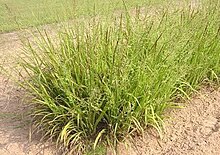| Coleataenia | |
|---|---|
 | |
| Coleataenia anceps | |
| Scientific classification | |
| Kingdom: | Plantae |
| Clade: | Tracheophytes |
| Clade: | Angiosperms |
| Clade: | Monocots |
| Clade: | Commelinids |
| Order: | Poales |
| Family: | Poaceae |
| Subfamily: | Panicoideae |
| Supertribe: | Andropogonodae |
| Tribe: | Paspaleae |
| Subtribe: | Arthropogoninae |
| Genus: | Coleataenia Griseb. (1879) |
| Synonyms | |
SorengiaZuloaga & Morrone | |
Coleataenia is a genus of grasses in the tribe Paniceae of the family Poaceae. Until recently this genus was part of Panicum . In 2010, Zuloaga, Scataglini, & Morrone proposed the transfer of the Panicum sections Agrostoidea and Tenera to the new genus, Sorengia. [1] However, that same year, because one of the new species' synonyms was in the valid genus Coleataenia, Robert J. Soreng determined that Sorengia was not a valid name for the new genus and re-published it as Coleataenia. [2] [3]